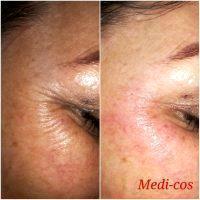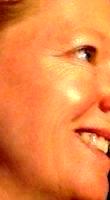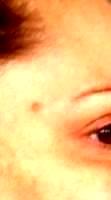Can Botox Help Crows Feet?
Botox works well to paralyze the muscles that contract around the eye (orbicularis oculi) and create the radial lines (crows feet).
If deep lines remain in the area when the muscles are no longer contracting, small amounts of a less hydrophilic (water attracting) filler can help (off label use of Volbella or Belotero).
In some cases, fractional Laser might be a better option to reduce the lines. (Janet Turkle, MD, Indianapolis Plastic Surgeon)
Lines visible with movement can best be treated with Botox. Etched in lines can be treated with Volbella – (off label). Non-ablative fractional laser resurfacing can be helpful as well. Using an eye cream recommended by a dermatologist can help repair the skin.

Botox In Crow’s Feet Helps Under Eye Wrinkles
For optimal safety, have these procedures performed in doctor’s office. (Linda J. Banta, MD, San Antonio Dermatologist)
Improving Crow’s Feet with Botox/Dysport/Xeomin, lasers, microneedling/prp, ultherapy/rf treatments
Botox can be used in combination with fillers, lasers, microneedling/prp, ultherapy and rf treatments to improve crow’s feet and can be combined on the same day.
See an expert for a formal evaluation. (Jason Emer, MD, Los Angeles Dermatologic Surgeon)
Crows feet treatment options
The appearance of crows feet is primarily influenced by muscle movement (the orbiculares which is activated with expression and when closing the eyes) and by laxity or loss of elasticity of the overlying eyelid skin.
Because of these influencing factors, an appropriately placed neuromodulator (Botox, Xeomin or Disport) can help by reducing excess muscle movement. Tightening or improving skin tone by regular medical skin care, chemical peels and other resurfacing options such as laser treatments may also help.

Botox Will Smooth Out Your Crow’s Feet
Crows feet are typically best treated with neurotoxins like Botox, Dysport, and Xeomin.
Personally, I think Dysport works best in crows feet, while Botox works better for other areas. We like to mix and match products and dilutions to what works best for each individual area in our experience.
If the crows extend down the cheek, then filler may be considered an option, Volbella works great for this. (Matthew Elias, DO, FAAD, Fort Lauderdale Dermatologic Surgeon)
Correction crows feet
What you need depends on what you are calling crows feet and how far down cheek extending. If your “crows feet” are just lateral to your eyes and are squint lines then toxin will correct them.

Botox Will Soften The Wrinkles On The Sides Of Your Eyes
Botox is the first-line treatment for crows feet but, depending on the depth of the lines, filler or laser resurfacing could then be added for further correction. (Nicholas Tarola, MD, Nashville Plastic Surgeon)
Treatments for crow’s feet
Botox is a purified protein used to address wrinkles associated with facial expression such as the crow’s feet seen around the eyes when one smiles or squints. I do not use fillers for crow’s feet but fractional CO2 laser resurfacing can help in addition to Botox for some patients. (Alex Eshaghian, MD, PhD, Encino Physician)
Botox for crow’s feet
I find that Botox works very well for the crow’s feet. Start with that and give it 2 weeks. If you still feel like you have etched lines you can do some fillers or Fraxel laser to diminish the etched lines.
In most cases Botox will take care of the problem. (Esta Kronberg, MD, Houston Dermatologic Surgeon)
I usually find that botox is enough to correct the crow’s feet . Fillers may be added if the lines remain deep and etched in. (Steven Wallach, MD, New York Plastic Surgeon)
The best initial treatment for the fine lines of the crow’s feet area is botox. You should allow two to five days to pass before you can evaluate the effect of the botox.
Injection of filler into the fine rhytids of the crow’s feet region risks bruising, because of the vascularity of this area, as well as palpable and visible lumpiness because of the thinness of the skin here.

Can Botox Reduce Crows Feet
Treating Challenging Crow’s Feet
Botox or Xeomin are usually excellent for treating the areas around the outer corners of the eyes/brows (Crow’s feet). In my practice, we rarely use fillers for this area as they are typically less than ideal and seldom required.
Chemical peels or laser treatments are sometimes used but they have benefits along with risks. Seek out a board-certified, fellowship trained Oculofacial Plastic Surgeon or Facial or General Plastic Surgeon to assist you — I’d avoid non-doctors from treating you. (Damon B. Chandler, MD, Philadelphia Oculoplastic Surgeon)

Can Botox Remove Crow’s Feet
If they are deep , botox would be used first , then I would fill them 10-14 days later after botox has relaxed the muscles . (Chad Robbins, MD, Nashville Plastic Surgeon)
Botox and Crow’s Feet
Botox is exceptionally good at treating the Crow’s feet. It is painless and takes effect in just a few days. (Michele S. Green, MD, New York Dermatologist)
Botox is the non-surgical injectible treatment that is especially effective in patients experiencing early signs of aging. Botox can specifically address crow’s feet. I suggest that you move forward and consult with a board certified facial plastic surgeon. (Ross A. Clevens, MD, Melbourne Facial Plastic Surgeon)

Can Botox Stop Crows Feet
Botox is an FDA approved treatment for the lines around the eyes known as crow’s feet. Most patients require between 6-12 units per side. If the lines extend down along the cheek, then these can be treated with filler injection in combination with Botox.
I recommend you see an experienced injector for an in person evaluation and to come up with an appropriate treatment plan. (Shaun Patel, MD, Miami Physician)
Treatment of crows feet
Usually this area can be treated successfully with botox or a similar neuromodulator (dysport, xeomin). If the lines are “etched” in the skin and not softened by the botox than laser resurfacing or dermal fillers may be appropriate.
Some of the newer fillers are meant to be injected specifically into these superficial lines. An experienced provider should be able to advise you as to the best approach. (Jean M. Casello, MD, Northborough Physician)

Can You Botox Crows Feet
Botox is typically all that is required to successfully treat crows feet. The eyelid and area around the eyelid skin is very thin and I would not inject Fillers in crows feet. (Brooke R. Seckel, MD, FACS, Boston Plastic Surgeon)
In general a neuromodulator like Botox is all that is needed to help smooth the lines along the outer and lower eye. If these lines have become “set” you may need a small amount of filler placed to help smooth the area but I would start with Botox first. (Nelson Castillo, MD, Atlanta Plastic Surgeon)
Combination of Botox and Filler to treat Crows Feet
Generally neuromodulators injections such as Botox are the primary treatments used to treat Crows Feet in most cases. In some cases, dermal fillers may play a role in minimising the depth of crows feet either by injecting directly around the peri-orbital region or to revolumize depth in the cheeks.

Under-eye Wrinkles Are Usually Separate
I seldom need to do more than botox for crow’s feet. if you wanted additional fine lines and wrinkle treatment beyond what botox does, you can consider a chemical peel or laser resurfacing procedure. (Sameer Bashey, MD, Beverly Hills Dermatologic Surgeon)
Botox alone will work in the majority of crow’s feet wrinkles.
Using fillers in this area is more difficult because the lines are a result of motion, ie smiling. Botox addresses the muscles in the region and is more direct. Modern day fillers only add volume.
Starting first with Botox is my recommendation. (Ernest Robinson, MD, Aliso Viejo Facial Plastic Surgeon)

Can Botox Treat Crow’s Feet
If a patient has very severe deep wrinkles, then filler may be necessary, but this is rarely the case. (David A. Sieber, MD, San Francisco General Surgeon)
Best treatment for crow’s feet
It’s impossible to make exact recommendations without assessing you in-person, or reviewing your photos. There are a variety of treatments for crow’s feet, depending on the depth and extent of the lines around your eyes, and whether or not you have any lines present at rest.
Generally speaking, I think Botox is the best starting point for treating the crow’s feet. Botox works by temporarily reducing muscle movement around the eyes to prevent the skin from creasing and forming expression lines (lines that are visible with movement and facial expressions).
The effects of Botox are typically visible for approximately 3-4 months. If you have deeper lines around your eyes that are present at rest, Botox will only soften them. For best correction, in addition to Botox, you will likely need some combination of dermal fillers and skin resurfacing lasers to stimulate collagen and smooth out the texture of your skin.
I would recommend scheduling a consultation with a cosmetic dermatologist to discuss your concerns, and determine the best treatment plan for you (Faiyaaz Kalimullah, MD, FAAD, Chicago Dermatologic Surgeon)
The best treatment for crows feet is botox. It is best to see a board certified plastic surgeon/derm for a proper assessment. (Martin Jugenburg, MD, Toronto Plastic Surgeon)
